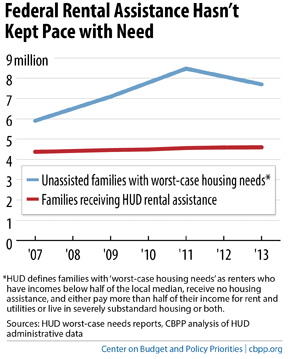BEYOND THE NUMBERS
The number of low-income households paying more than half of their income for rent or living in severely substandard housing remains 30 percent above pre-recession levels despite the improving economy, a new Department of Housing and Urban Development (HUD) report shows. Policymakers should keep that in mind during this year’s budget process, when they’ll be allocating federal resources.
In 2013, 7.7 million households had “worst-case housing needs” (HUD’s measure of the most serious housing problems), the report shows — up from 5.9 million in 2007. Most of them include a child, elderly individual, or person with disabilities. These data don’t include many of the more than 1 million households that were in shelters or on the streets in 2013.
Nearly all (97 percent) of the 7.7 million households paid more than half of their income for rent and utilities. Families that pay such a large share of their income for housing have great difficulty meeting other basic needs like food or medication, and they risk losing their homes if they can’t keep up with rent payments. Recent research also has found that unaffordable housing costs can affect children’s cognitive development.

Wages aren’t likely to rise enough to significantly close the gap between earnings and rental costs any time soon, so the need for rental assistance among working families, as well as elderly and disabled individuals on fixed incomes, will remain high. The President’s budget boosts funding for HUD rental assistance by $3.8 billion in 2016 in order to provide affordable housing for about 100,000 more low-income households while maintaining assistance to more than 4.7 million families. Most of this increase would go to restoring 67,000 Housing Choice Vouchers cut by the sequestration budget cuts.
